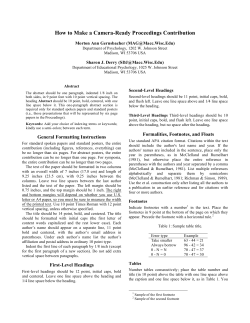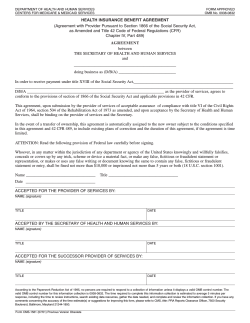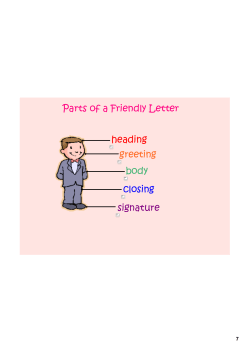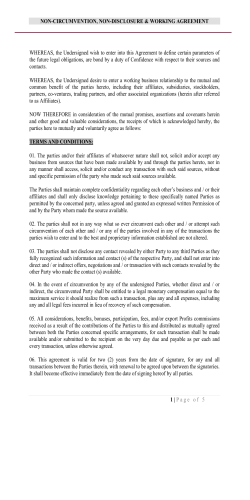
Basic Letter/Memo Formats Parts, layout & rationales Letters ... Full Block
Basic Letter/Memo Formats
Parts, layout & rationales
Letters ... external communication
Full Block
Most formal.
Straight left edge with return
address (except for letterhead,)
date, inside address, salutation
and signature block hard left
on page.
Professional, detached tone.
Emphasis on company or
sender/receiver positions
rather than relationship.
Return addre ss
Return Address
Date of Letter
Date
Title, Name, Position
COMPANY
Street Address
City, Prov/State
Zip Code
In side Addre ss
Salutation
Dear Title Surname
Opening (S MR) Section
Generally used at beginning of
relationship-building process
when trust / knowledge factor
is low and/or undeveloped.
Also used when the
relationship is strictly business:
no personal relationship
intended or encouraged.
Supporting Detail Section
Courteous Action Clo si ng
(RDC)
Sincerely
Signature above typed name
Name
Position
DW:jb
enc
Return Address
Return addre ss
Date
Date of Letter
Modified/Semi-Block
More personal/casual.
Title, Name, Position
COMPANY
Street Address
City, Prov/State
Zip Code
Date/Signature lines move right.
Inside Addre ss
Salutation
Sometimes, paragraphs are
indented (although that can
disrupt list aligment and heading
placement in longer documents.)
Dear Title Surname
Word choice more personal.
Opening (S MR) Section
Supporting Detail Section
Action Closing (RDC)
Sincerely
Signature above typed name
Name
Position
Relationship emphasized.
Employed as relationship
between sender and receiver
develops: still businesslike and
professional, but clearly a
friendship developing between
the correspondents.
DW:jb
enc
Summary: These formats represent the extremes of formality/informality – you’ll find numerous choices
in between representing different stages in the relationship between the writer and reader. Many
companies also have standard styles for different types of correspondence: study and use them as part of
your situation analysis when you are employed by a company or a client.
BASIC LETTER/MEMO FORMATS: Parts, layout & rationales
1/1
David Wiens ©
Memos - INTERNAL COMMUNICATION
Pre-printed forms to speed writing/reading. Key is concise but very specific subject line. Initial or
signature beside name at top or underneath final paragraph
Mem o h ead
Re cipie n t plu s p o sitio n
S e nde r plu s p o sitio n
T o:
F ro m :
D ate:
S ub ject:
cc:
Co re m e ssa g e /re sp on se
Co pie s to
O pe ning (S M R ) S e ction
S u ppor tin g De ta il S e ction
Actio n Clo si ng ( R DC )
S igna ture or initia l
Faxes are much
like memos but
include number of
pages in the
masthead.
Emails are
virtually identical
to memos except
for initials or
signature
Document Headings
Headings break up larger documents into logical sections so that the reader can locate key information
quickly and easily. Headings should be distinctly formatted so that the reader can spot major and minor
sections immediately. Here is a simple example of 4 levels of headings using positioning, capitalization,
boldface and underlining to indicate the different levels:
"!#%$'&"(
)*)+)*)+)+)-, ."/102."34
M@NPORQPSUTWV XYQZN\[']^X_TYX
`ba cUdecfahgRi
jlkWmon"p^pPqYr
sbt uwvxutzyR{
|~}f"f ^}%
x}R1L
o%f
5
687:92;"<+6
=
>@?'A2?
B CEDGFHDIC JLK
See how the
formatting and
alignment is distinct
for each level. The
reader can tell
instantly how each
section is related to
what is before/after.
b wxI^
#Z%
:¡W ¢f£
¤¦¥ §§©¨Pª¬«~W®_¯Y®
Normally, a short introductory paragraph indicats the major second level headings to follow. Each
heading should be separated from next level by 1 line.* Use positioning plus bold/underlining/italics
techniques to indicate levels of importance, and put white space between headings and sections to make
each easy to spot and respond to.
°+±%²^³%´µ2¶ ·8¸º¹Z±Z»Zµ2¼´R½%¾¿¾f¹Z³^À"¶ µÂÁP±Ãµ±Z¾_²%ÄW¼ ÅfÆ^¼ ÇR±
: they should concisely reveal the content of the section they
introduce—e.g. Not bare bones “Costs” but rather “Hidden Costs” or “Anticipated Startup Costs.” Reveal
more than just the basic content of the section in the heading.
Combined with strategic use of È1ÉÊ Ë_ÌÎÍRÏWÐ%ÑWÌ and parallel ÒÓÊ Í_ËYÍ (bulleted & numbered), headings make it
possible to move backward and forward in a document with a speed and accuracy not possible in a
traditional essay of paragraphs.
BASIC LETTER/MEMO FORMATS: Parts, layout & rationales
2/2
David Wiens ©
© Copyright 2025
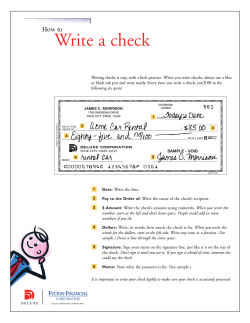



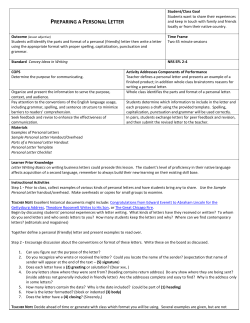

![[Insert Title] JoSSonline Initial Submission Template [St](http://cdn1.abcdocz.com/store/data/000288363_1-994a9a489d2cd6618bd3355e59e187ac-250x500.png)
